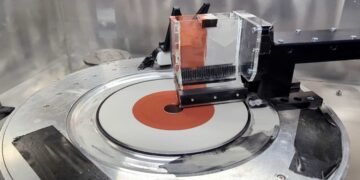A pair of cylindrical gold nanoparticles, where the plasmonic excitations are represented by the clouds surrounding the nanoparticles. Credit: University of Exeter.
A team of scientists have solved the longstanding problem of how electrons move together as a group inside cylindrical nanoparticles.
The new research provides an unexpected theoretical breakthrough in the field of electromagnetism, with perspectives for metamaterials research.
The team of theoretical physicists, from the University of Exeter and the University of Strasbourg, created an elegant theory explaining how electrons move collectively in tiny metal nanoparticles shaped like cylinders.
The work has led to new understanding of how light and matter interact at the nanoscale, aland has implications for the realization of future nanoscale devices exploiting nanoparticle-based metamaterials with spectacular optical properties.
Metallic nanoparticles have a positively charged ionic core, with a cloud of negatively charged electrons swirling around it. When light is shone on such a metallic object, the electronic cloud is displaced.
This displacement causes the whole group of electrons to be set into oscillation about the positive core. The group of electrons sloshing back and forth behaves like a single particle (a so-called quasiparticle), known as a “plasmon.”
The plasmon is primarily characterized by the frequency at which it oscillates, which is known as the plasmon resonance frequency.
Exploring how the resonance frequency of the plasmon changes depending on the geometry of its hosting nanoparticle is a fundamental task in modern electromagnetism. It is commonly thought that only some particular nanoparticle geometries can be described with analytical theory—that is, without recourse to heavy, time-consuming numerical computations.
The list of geometries permitting an analytical description is widely believed to be very short, being composed of only spherical and ellipsoidal nanoparticles.
This fact is highly inconvenient due to the experimental ubiquity of cylindrical nanoparticles, which arise in a variety of aspect ratios from long, needle-like nanowires to thin, pancake-like nanodisks.
In the research, the researchers addressed how plasmons in cylindrical nanoparticles oscillate. By using a theoretical technique inspired by nuclear physics, the researchers built an elegant analytic theory describing the behavior of plasmons in cylinders with an arbitrary aspect ratio.
The theory has enabled a complete description of cylindrical plasmonic nanoparticles, describing simply the plasmonic resonance in metallic nanoparticles from nanowires to circular nanodisks.
The two condensed matter theorists also considered the plasmonic response of a pair of coupled cylindrical nanoparticles and found quantum mechanical corrections to their classical theory, which is relevant due to the small, nanometric dimensions of the nanoparticles.
Dr. Charles Downing from the University of Exeter’s Physics and Astronomy department explains: “Quite unexpectedly, our theoretical work provides deep, analytic insight into plasmonic excitations in cylindrical nanoparticles, which can help to guide our experimental colleagues fabricating metallic nanorods in their laboratories.”
Guillaume Weick from the University of Strasbourg adds: “There is a trend for increasing reliance on heavy duty computations in order to describe plasmonic systems. In our throwback work, we reveal humble pen-and-paper calculations can still explain intriguing phenomena at the forefront of metamaterials research.”
The theoretical breakthrough is of immediate utility to a swathe of scientists working with nano-objects in the cutting edge science of plasmonics. Longer term, it is hoped that plasmonic excitations can be exploited in the next generation of ultra-compact circuitry, solar energy conversion and data storage as our technology becomes increasingly miniaturized.
Plasmonic modes in cylindrical nanoparticles and dimers is published in Proceedings of the Royal Society A.




































